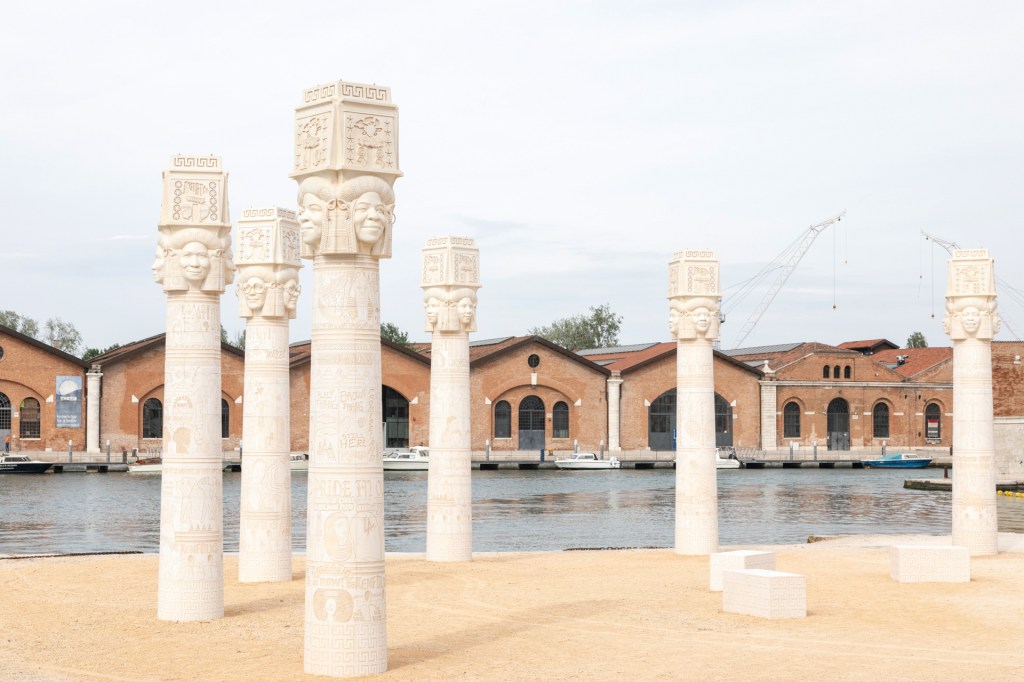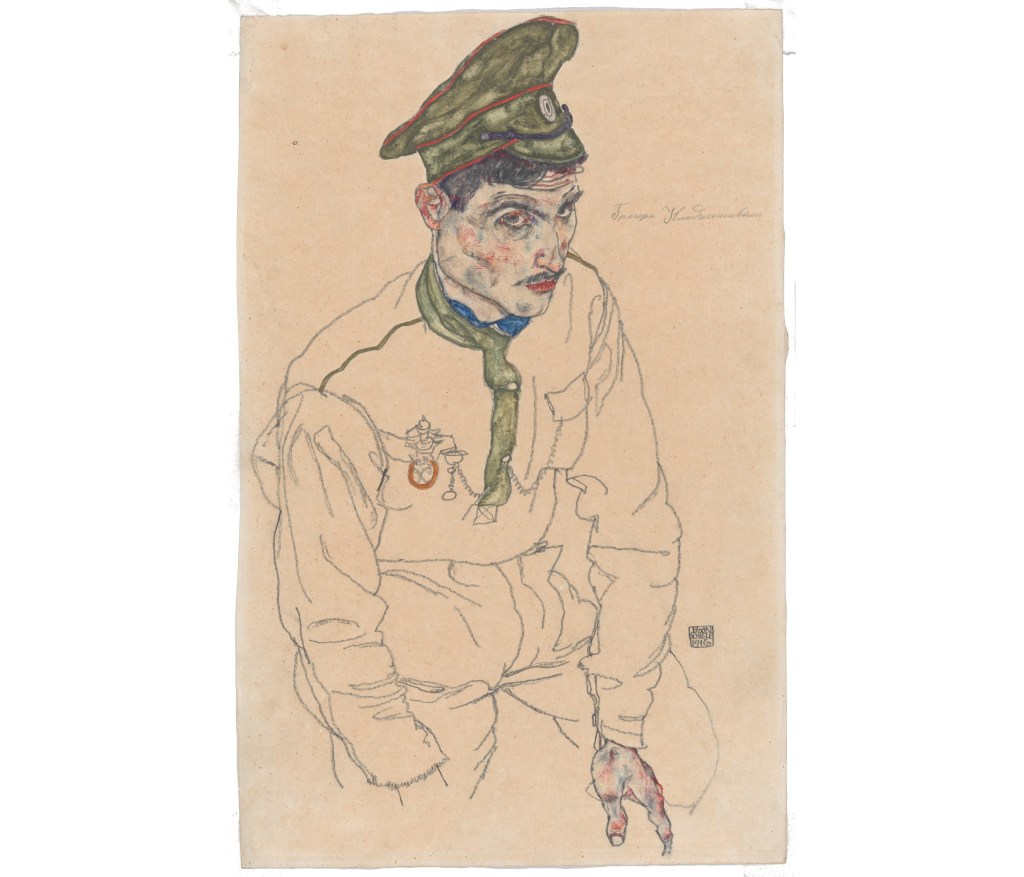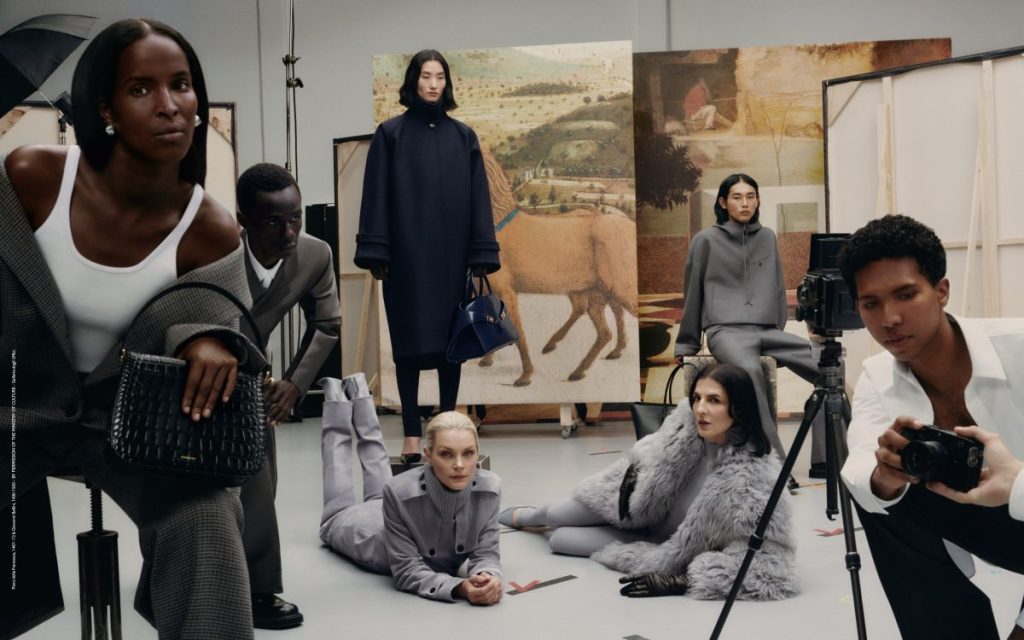IF I HAD TO DESCRIBE the Venice Biennale in one word, it would be “inclusive.” Curated by Adriano Pedrosa, this year’s edition, titled “Foreigners Everywhere,” is inclusive in the sense that the title implies: it boasts a diverse roster of artists from across the world, with a special focus on both Indigenous artists and those from the global south. But it is inclusive in other ways too. The show brings together artists both formally trained and self-taught, and it features works in every conventional medium, style, and genre that one might expect. It does all this without privileging any one artistic mode over another, offering inclusivity as a statement against the aesthetic biases and aversions that have for so long proven exclusionary, often along lines of race, gender, and ability.
What Pedrosa offers is a cultural cacophony: proof that we can no longer pretend to live in a monoculture. The show includes three “Nucleo Storico” sections focused on 20th-century works from Latin America, Africa, the Middle East, and Asia. One section is titled “Abstractions,” another “Portraits”: these two genres have often feuded, especially over political efficacy, but here, no aesthetic category is hierarchically favored over another, and no artist is given prominence. Looking at so much art hung salon-style in gray rooms, the viewer is overwhelmed and unsure where to focus, as if attending an art fair. Hierarchy is abolished.
As a result, the underappreciated artists championed here are difficult to adequately appreciate. While the show welcomes overlooked perspectives from under-recognized artists, for the most part, Pedrosa stops short of allowing those perspectives to transform any norms. The “Abstractions” and “Portraits” sections are themed unimaginatively, even conservatively.
The third “Nucleo Storico” section, however, has more teeth. Titled “Italians Everywhere,” it features works as seemingly innocuous as a painting of a shoe by Domenico Gnoli. But taken together, the works are a sly retort to Italy’s current anti-immigration right-wing government, showing that Italians have been foreigners too. The section enlists a radical if historical rethinking of the exhibition format: paintings are hung on transparent easels designed in 1968 by the Italian-Brazilian architect Lina Bo Bardi, herself an expat. She originally designed them for the Museum of Art São Paulo, where Pedrosa is director, to eradicate hierarchy. Taking paintings off the walls, she did away with the chronological and geographic structures that tend to dictate museological narratives, enabling heterogeneous canvases to meld into a single view.
But outside of the “Italians Everywhere” section, there is considerably less melding in Pedrosa’s art salad—which seems to be the point. The artists he has included hardly share a conversation: many work(ed) in contexts that are indifferent to or lack access to academic art training, such as Indigenous communities (André Taniki), psychiatric institutions (Aloïse Corbaz), or regions of the world less invested in the distinction between high and vernacular art (Esther Mahlangu).

One such artist, Santiago Yahuarcani, worked for decades before he began exhibiting outside the Uitoto Nation in Northern Amazonia. His surrealist renderings of humanoid figures, done on tree bark, are some of the best works in the show.
Yet looking at Yahuarcani’s work and at others clearly not envisioned for a viewer like myself, I began to wonder: who benefits most from all this inclusion, and at what expense? Many of the artists in the show are no longer alive, and many have spent much of their careers indifferent to exhibitions like the Venice Biennale, working in other contexts instead. Some addressed sacred knowledge never meant to be shared. In cases like those, are artists—or their communities or heirs—the foremost beneficiaries? Or might it be art dealers and/or well-meaning liberals looking to learn about diverse experiences who stand to gain?
The answer, of course, is that it depends. But throughout, representation and inclusion are positioned as a de facto positive for artists. It’s a notable counterpoint to this year’s Whitney Biennial, a show with its own diverse roster wherein curators showcased artists who have opted for opacity over representation in works that question the ethics of legibility and of being on display.

Throughout “Foreigners Everywhere,” the viewer is asked to learn about perspectives unlike their own, rather than offer aesthetic judgments. With over 300 very different artists, each visitor is bound to encounter work for which they are not the target audience—and for which they lack the adequate context to assess.
Learning, of course, is generally considered a constructive pastime, so long as it does not entail the kind of extractive relations that anthropological exhibitions and World Fairs too often risk. Pedrosa largely shies away from addressing this risk. Instead, he posits inclusion in such an esteemed exhibition as inherently good—never mind the lengthy history of exhibiting institutions conquering the world and then showing off the spoils.
In spite of this, a couple of living artists who are invested in the fraught category that is “art” contributed work expressing skepticism toward this kind of conquering. Frieda Toranzo Jaeger greets visitors to the Arsenale with a giant polyptych. To make the work, the Mexican artist hired her Indigenous family members to embroider scenes onto her painted canvases, calling the act a kind of “semiological vandalism”—poking literal holes in the perceived preciousness of painting as reified by Europeans and contorted to justify white supremacy, as if other cultures lacking painting-filled museums are somehow inferior. Her work is filled with exuberance and rage by way of embroidered lesbian orgies, menacing machinery emitting blood-red clouds, and watermelons showing solidarity with Palestine. Jaeger is too smart and savvy simply to express gratitude for inclusion on the terms of the colonial institution offering it: her work advocates a shift in values instead.

IF PLURALITY IS PEDROSA’S POINT, one palpable side effect is the sense of curatorial box-checking, especially where mediums are concerned. While the exhibition includes some real discoveries in the mediums of painting and fiber—I liked Anna Zemánková, Huguette Caland, and Ahmed Morsi—selections in photography and video feel simply uninspired. Long videos were tucked away at the end of the lengthy Arsenale, where viewers are bound to arrive depleted of time and attention.
Still, the something-for-everyone approach is an understandable reaction to the bad rap that judgment has been given of late. As in so many fields, white Euro-American men have largely controlled the rules of what constitutes good art, and these rules conveniently reified their own superiority, much as the wine-classifying system developed in France continues to proffer that French wine is the best. In response, we are witnessing backlash to the very notion of judgment itself: all biases are problematic, all favoritism passé.
Which is tricky, as historically, discernment has been the curator’s job. Curators are supposed to be aesthetes with finely tuned sensibilities, though this has predictably proven elitist, with the role long reserved for those with access to things like art history degrees and art collections. To avoid this privileged privileging, Pedrosa offers something for everyone: if all aesthetic decisions need to be understood from a particular vantage, then all are valid. In turn, the viewer is asked to play the role of learner, save for the few cases where they feel “seen.” (Art history nerds will recognize this proposition as Warburgian.)
Turning to relativism when dismantling canons or any master narrative is understandable. But it is also less convincing—and more disappointing—than proposing new, more nuanced narratives. The critic Becca Rothfeld describes this kind of cultural egalitarianism as “misplaced” in her new book, All Things Are Too Small, calling it a distraction from the left’s long-held mission of economic equality. In the absence of globally redistributed wealth, she writes, “the democratization of culture is a consolation prize” that “not only fails to make anything happen, but confirms our impotence, our deep recognition that nothing is happening.” That is certainly how I felt while taking in the democratized culture of the Venice Biennale, pounding cappuccinos and looking at art with Trump on trial and a genocide underway.
More than a distraction, cultural egalitarianism is also “wretched,” per Rothfeld. She writes that “the kinds of creatures for whom love and art mean anything at all are the kind with biases and aversions.” To love something passionately, she adds, is to love something else less—or not at all.

There are advantages to certain prejudices. In fact, I thought the best parts of the Venice Biennale relate to the one bias the exhibition reveals: Pedrosa gives outsize attention to fiber art in the works he selected from the 20th century. Works by Susanne Wenger, Olga de Amaral, and Pacita Abad are some of the best in the show. These and other inclusions make a strong case for the formal brilliance of women who were excluded from the canon in their day. Unfortunately, Pedrosa does not carry this thread through to this century, as astonishingly few young fiber artists are included, given the lineage he charts—artists who like Jaeger, might have something to say about the power dynamics at play.
“FOREIGNERS EVERYWHERE” HAS RECEIVED few positive reviews. Though I think much of the criticism leans frighteningly conservative, I also find the show hard to defend—and there are worse consequences than a merely OK exhibition. In the New York Times, Jason Farago framed the show as fodder for his repeated claim that culture has somehow ended, now that the internet has enabled us to have many simultaneous conversations that collapse time and space into a cacophony. (That this post-monocultural era also occurs at a time when the art world is more diverse than ever before remains the elephant ever looming in Farago’s room.) Though I think his doomsaying is wrong, I also fear that “Foreigners Everywhere,” with its something-for-everyone, anything-goes approach disguised as democratizing culture, can be contorted to feed agendas like his.
A show featuring artists with a wide range of cultural backgrounds doesn’t have to be a relativistic cacophony: it can be both biased and inclusive. Sohrab Mohebbi achieved this balance when he curated the most recent edition of the Carnegie International, which made a beautiful and inspiring case for political abstraction. The show advocated for ingenious things abstract artists do: adapt to forms of oppression with clandestine messages, respond to vernacurlar patterns and their cultural histories, and give form to essential human emotions. Pedrosa’s breed of inclusion instrumentalizes artists to make a political point, at times undermining art itself; Mohebbi’s made a case instead for the power of artwork—and all the imperfect, slow ways art might engage the political sphere. By contextualizing these engaged abstractionists among coconspirators, he enhanced their impact.

In both shows, it was the artists who did the most inspiring work to grapple with the inherently fraught task of trying to bring non-Western and anti-colonial perspectives into the imperialist inventions that are the museum and the Biennale. A standout in Venice is Lauren Halsey, whose concrete columns tower outside the Arsenale , impressed with reliefs that borrow from the vernacular funk of her neighborhood, South Central Los Angeles. Handmade signs from local businesses, vivacious and full of character, form the trunks; the capitals are sculptural portraits of local friends made monumental. The columns are decidedly Egyptian in style, asserting the foundational contributions of Black culture and forming a continuum between the vernacular contributions of both the ancient society and the artist’s own community.
Halsey does not make Pedrosa’s mistake of trying to uplift vernacular aesthetics for a fine art context which, while endeavoring to flatten certain kinds of hierarchies, can ultimately reinforce them instead. Halsey is clear-eyed about how approaches that may seem egalitarian can also be extractive, neoliberal rather than democratic. She plays the game her way, using proceeds from her work to fund food-justice initiatives in her community and to redistribute wealth. She refuses to allow the powers that be to pat themselves on the back while distracting from the world’s real problems.



